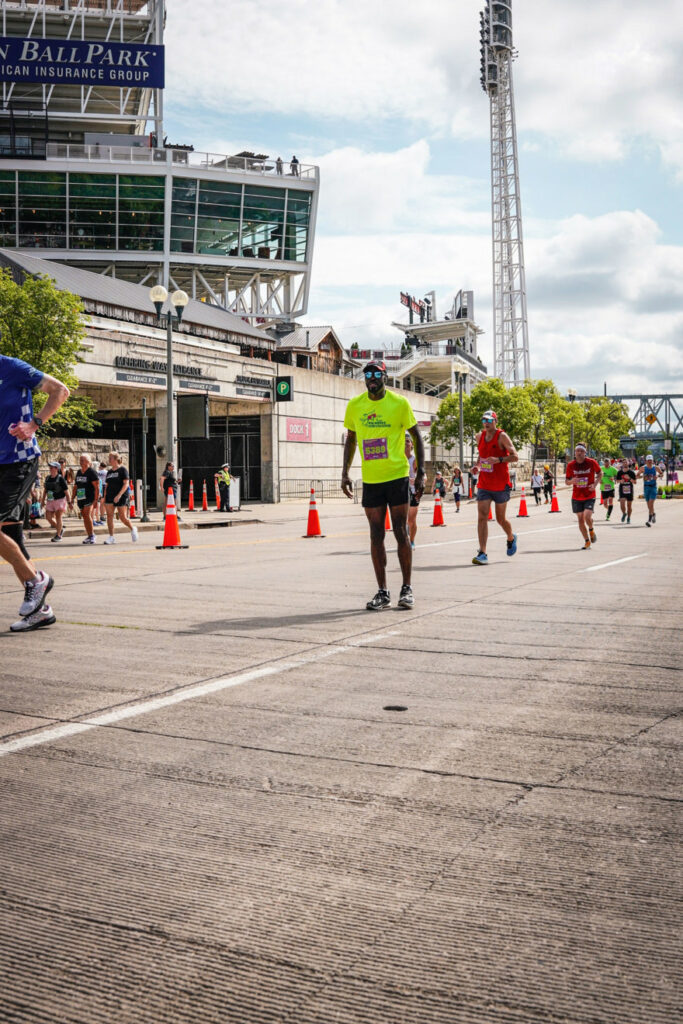You’re at mile 18 of your marathon race. Things are starting to get tough–you’re starting to feel tired, but you’re able to maintain your pace. A couple of minutes later, though, you start to feel your calf muscles tighten, and your pace slows. Soon enough, your calf muscles completely “lock up” and you can’t get them to relax. You have to stop and walk because of the tightness and pain in your muscles.
As you’re stretching your calves on a nearby curb, you might be wondering, why did this happen to me? What leads to these muscle cramps? And what can I do to prevent this in the future?
Muscle cramps are a common and frustrating issue for endurance athletes. A heavy bout of cramps can turn a great race into a “struggle fest” to make it to the finish line. Gaining a better understanding of the science behind muscle cramps will help you prepare better for your next race, lessening the likelihood that “cramping up” keeps you from hitting your goal time.

Exercise-associated muscle cramps (EAMCs) are “painful, involuntary contractions of a skeletal muscle during or shortly after exercise”1. EAMCs can range in severity, but in most cases they dissipate over time without need for medical attention or serious intervention. EAMCs tend to occur in muscles that cross two joints (examples: your quadriceps on the front of your thigh, your calves on the back of your lower leg). The incidence of cramps with exercise increases in hotter months of the year, but cramping can occur in any weather.
Traditionally, EAMCs were thought to occur because of dehydration and loss of electrolytes due to heavy sweating during exercise. However, there is more scientific evidence that is contrary to this explanation than there is in support of it. Multiple studies that compared cramping vs. non-cramping athletes during endurance competitions show that there was no difference in serum electrolyte levels (how much electrolytes are in your blood) between the two groups, both during and after competition2,3. Another study showed that EAMCs occurred as the subjects became fatigued with exercise, regardless of whether they were well-hydrated or dehydrated4. So, it is unlikely that dehydration and electrolyte loss alone are major factors in cramping during your race.
A different explanation for muscle cramps during endurance exercise is fatigue. Muscle fatigue can be defined as a progressive, exercise-induced reduction in the ability of a muscle to produce force or power. So, as you run for longer periods of time, it becomes more difficult for your muscles to produce the same amount of force that they could at earlier stages in the race. Eventually, you begin to run slower, even though you may feel that you’re working hard as ever to keep pace.
But how does this muscle fatigue lead to cramps? By altering something called neuromuscular control5. Your muscles are controlled by your nervous system (the “neuro” in neuromuscular), which can be broken down into two basic parts: 1) the central nervous system, which is your brain and spinal cord and 2) your peripheral nervous system, which are the nerves that branch off of your spinal cord to connect to all of the muscles in your body. Signals for muscles to contract and relax are first sent by your brain, then travel down your spinal cord, and are finally sent to the muscle through peripheral nerves. When you get fatigued during a race, the amount, intensity, and duration of these signals can change. This change in the signals (also called neuroexcitability) is thought to be what causes cramps to occur–if your muscles are receiving too much input to contract but not enough input to relax, then they will not relax as they should. This inability for muscles to relax after contracting is the cramping that you experience.
So, changes to neuroexcitability appear to be the driver behind muscle cramps, and muscle fatigue can affect this neuroexcitability. However, it’s important to point out that there are several other factors that can either alter your nervous system function or contribute to muscle fatigue1. They include:
Look at the factors listed above. In order to address your cramping issues, you have to take a look at more than just your running workouts, and do more than just drink more Gatorade or eat more bananas. You have to take a holistic look at yourself as an athlete. Ask yourself these questions:
Give these questions some consideration before your next big race, especially if you frequently deal with EAMCs.
The quickest way to get rid of a cramp during a race is to stop running and stretch the area that is cramping6,7. You can also do some gentle self-massage while stretching. If the cramping becomes intense or is happening in several different muscles at the same time, you may need to have someone help you stretch out.
Also, continuing to hydrate with water or a sports drink can be helpful, but keep in mind that it takes 13 minutes or longer for those fluids to be absorbed into the bloodstream8. There is limited evidence that drinking a small amount of pickle juice can alleviate cramps faster than drinking plain water9. However, most races don’t give away pickle juice at water stops, so if you plan on using it, bring your own.
I decided to do a deep-dive on the research on EAMCs because I have personally experienced muscle cramps while running a marathon. I know how frustrating it is to spend months preparing for a race, only for it to be derailed in the last few miles. Previously, I did not take into account all of the different factors that affect the fatigue that leads to muscle cramps. Now that I know better, I will do better the next time. And now that you understand muscle cramps, I hope you’ll do the same.
Want to learn more about proper hydration during your runs? Check out my Instagram post here.
Written by: Brian Barney PT, DPT CSCS